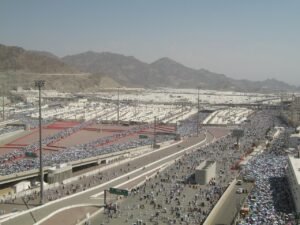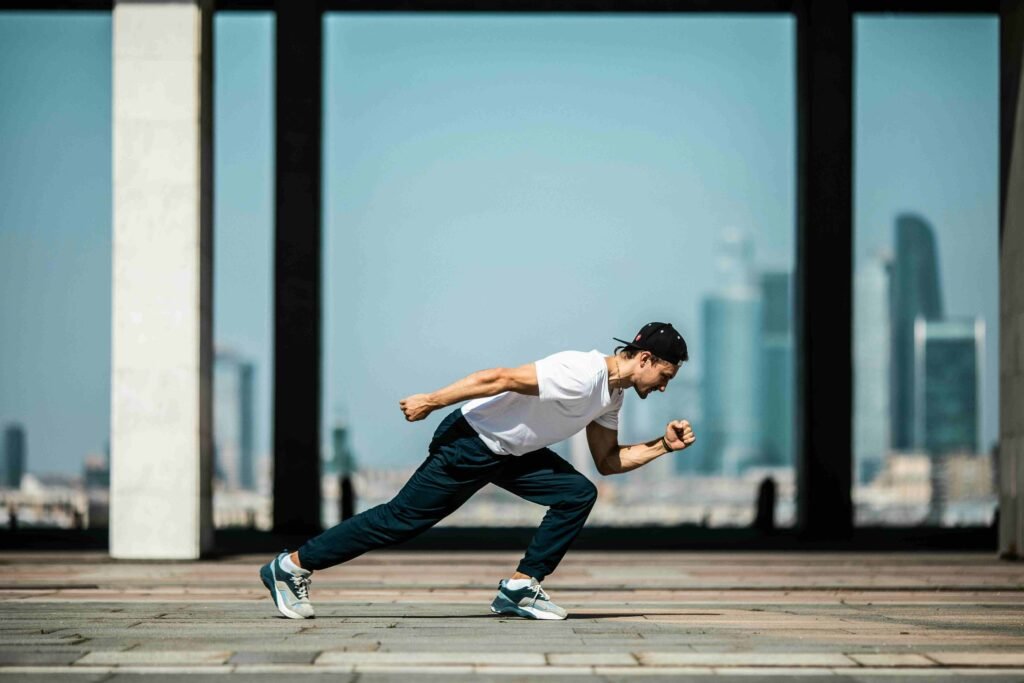The main rituals of Hajj begin on the 8th of Dhul-Hijjah. This is the first day of Hajj. Those who have come with the intention of Hajj and are performing Tamattu’ would have already completed their Umrah. Now, they need to perform only the rituals of Hajj, which should be carried out in the following sequence.
8th Dhul-Hijjah – The Day of Tarwiyah
What to do on the 8th of Dhul-Hijjah
On the 8th of Dhul-Hijjah, after sunrise, leave your hotel (in Makkah/Aziziyah/Shisha) wearing the Ihram of Hajj and reach Mina before Dhuhr. Spend the day and night in Mina’s tents and perform the five daily prayers there in Qasr form. Before donning the Ihram on the 8th of Dhul-Hijjah, pack your bag. Bring a small bag that is easy to carry, as you may need to walk a few miles with it. Leave your larger luggage with valuable items, extra cash, and other belongings securely locked in your hotel room or deposit it with the Saudi Muallim office, taking a receipt/memo for safekeeping.
Wearing Ihram on the 8th of Dhul-Hijjah
Before wearing the Ihram on the 8th of Dhul-Hijjah, complete your personal hygiene routine, such as trimming nails, cleaning pubic hair, and shortening the mustache. Do not trim your beard or cut your hair. These hygienic acts are Sunnah. It is preferable to complete them before the 1st of Dhul-Hijjah. Before wearing the Ihram, take a bath; if bathing is not possible, perform Wudu. Menstruating women should also bathe, wear napkins, and put on regular clothes. They should follow all the rituals of Hajj except entering the mosque, touching the Quran, praying, or performing Tawaf until their menstruation ends. Once their period is over, they should perform Tawaf and pray.
Men can apply oil or talked to their hair and use perfume on their body, head, and beard before donning the Ihram. However, no perfume should touch the Ihram garments. If it does, wash the area thoroughly three times. Women are prohibited from using perfume under any circumstances, whether in the mosque or outside the house. Using perfume is haram for women.
Women should leave their face and wrists uncovered. They cannot use a niqab to cover their face at all times. However, they can cover their face in the presence of non-Mahram men.
Men should wear the Ihram garments in a manner that covers from above the navel to below the knees, ensuring their shoulders and body are covered with the Ihram cloth. A sewn belt may be used to secure the garments.
The ideal Sunnah method is to wear the Ihram garments before an obligatory prayer, perform that prayer, and then declare the intention for Hajj or start chanting Talbiyah while on the ride. If there is no obligatory prayer, you may perform Wudu, wear the Ihram garments, and offer two Rakat of Nafl or Tahiyatul Wudu prayer. After the prayer, declare your intention for Hajj. If the Ihram is worn after an obligatory prayer, no additional prayer is necessary. If circumstances or the environment do not permit Wudu or prayer, wearing the Ihram garments and starting Hajj by declaring intention or chanting Talbiyah is sufficient.
Where to Wear Ihram
From your hotel or residence in Makkah/Medina, wear the Ihram garments and declare the intention for Hajj. This is obligatory. You do not need to go to a Miqat for this. Residents within the Haram boundaries will also declare their intention for Hajj from their residence. Those coming from outside the Miqat will declare their intention for Hajj at the Miqat before entering.
After wearing the Ihram garments and boarding the vehicle heading to Mina, declare your intention for Hajj aloud, including menstruating women, who should bathe and wear napkins before doing so.
لبيك حجا “Labbaik Hajj
“I am here for Hajj.”

Talbiyah
Begin reciting the Talbiyah with the proclamation of Tawheed and continue until the stoning of Jamratul Aqabah on the 10th of Dhul-Hijjah.
لبيك اللهم لبيك لبيك لا شريك لك لبيك
إن الحمد والنعمة لك والْمُلْكَ، لا شريك لك.
“Labbaik Allahumma Labbaik, Labbaika Laa Shareeka Laka Labbaik. Innal Hamda, Wan Ni’mata, Laka Wal-Mulk, La Shareeka Laka.”
“Here I am, O Allah, here I am. Here I am. You have no partner; here I am. Surely all praise and blessings are Yours, and so is the dominion. You have no partner.”
Do not recite it so loudly as to disturb or inconvenience others. Women should recite it in a low voice or silently. Reciting Talbiyah frequently is recommended, whether standing, sitting, or lying down, with or without Wudu. It can be recited at all times.
After Wearing Ihram
Your Hajj Ihram is now complete, and wearing it was obligatory. Remember that you are now in the state of Ihram, and all its rules and regulations apply to you. Learn what is permissible and what is prohibited during Ihram by referr
https://travelinmakkah.com/ihram/ng to:
There is no instruction in Hadith to perform Tawaf of the Kaaba or Sa’i between Safa and Marwah on the 8th of Dhul-Hijjah. Hence, avoid such unnecessary acts, as they are baseless and not part of the Sunnah.
At the start of Hajj, Satan becomes very active and tries to corrupt the pilgrimage by instilling discord, arguments, anger, pride, gossip, immodesty, misguidance, and unsanctioned practices in pilgrims.
When you left your home for this journey, you were advised to carry three essential qualities with you: patience, sacrifice, and forgiveness. These qualities are crucial to ensuring the success of your Hajj. During the days of Hajj, you will be living with different groups from the agency. Sometimes, disagreements may arise. Handle such situations with patience and avoid arguments or quarrels.
Traveling to Mina
According to the practices of the Prophet, the Sunnah is to depart for Mina in the morning of the 8th of Dhul-Hijjah after performing the Fajr prayer in Makkah. However, given the current situation where 2.5 — 3 million pilgrims travel approximately 7–8 km to Mina using 9–10 thousand vehicles in the morning, the resulting traffic congestion and standstill are easily predictable.
Therefore, Saudi Muslims, based on the fatwas of Saudi scholars, begin transporting pilgrims to Mina starting midnight on the 8th of Dhul-Hijjah. While this action is contrary to the Sunnah, as it is being done out of necessity, it does not invalidate the Hajj. Pilgrims are gradually transported to Mina from midnight until the following morning. Therefore, inquire about your Saudi Muallim’s plan for transporting pilgrims to Mina and prepare for Ihram accordingly. It is best to start preparing for Ihram 2–3 hours before the scheduled departure.
After arriving in Mina
Upon reaching Mina, all prayers should be performed at their designated times and shortened (Qasr). This shortening of prayers is not related to travel but is specific to Hajj. During the days of Hajj (8th–13th of Dhul-Hijjah), the Prophet (peace be upon him) led shortened prayers with both the residents of Makkah and those who traveled from outside the Miqat. He made no distinction between residents and travelers, nor did he direct local Makkah residents to perform full prayers separately. Therefore, it is Sunnah to perform all obligatory prayers of four rak‘ahs as two rak‘ahs (except Maghrib and Fajr, which remain three and two rak‘ahs, respectively). During this time, there is no need to offer Sunnah or Nafl prayers, as it is Sunnah to omit them. However, while in Mina, you may perform the two rak‘ahs of Fajr Sunnah and one or three rak‘ahs of Witr after the Isha prayer.
It is preferable to pray in congregation with your group inside your tent or near Masjid Khayf if your tent is close to the mosque. Some people may hold differing views regarding the above ruling and choose to pray full prayers in Mina, citing the specific distance and duration of travel as reasons. These individuals often rely on fiqh rulings from their respective Imams rather than direct actions of the Prophet (peace be upon him) or his companions. In such cases, it is advisable to follow the Sunnah and perform shortened prayers, even if it means praying alone or in a smaller congregation, without engaging in disputes or arguments.
Staying in Mina until sunrise on the 9th of Dhul-Hijjah is Sunnah, after which the journey to Arafat should begin. While in Mina, spend your time performing prayers, reciting the Qur’an, engaging in Tasbih (glorification of Allah), Tahleel (declaration of the oneness of Allah), Istighfar (seeking forgiveness), du‘a (supplication), and dhikr (remembrance of Allah). Continue reciting the Talbiyah. Staying in Mina symbolizes a simple and humble lifestyle. Avoid wasting this valuable time by sleeping excessively, engaging in idle conversations, or wandering aimlessly.
If any of the rules of Ihram are violated, a fidyah (compensation) must be offered later. If the Hajj is obstructed, fidyah similar to that of Umrah must be given to resolve the matter and exit Ihram.

Information about Mina
- The tents in Mina are permanent and remain unused throughout the year except for the 5–6 days of Hajj. They are cleaned and prepared by licensed Saudi Muslims for Hajj management.
- On the first day in Mina, the roads and tents are very crowded. Many pilgrims get separated from their groups and lost during this day.
- All tents in Mina are equipped with air conditioning or air coolers. Each tent can accommodate around 40–50 pilgrims. Each individual is provided with a small mattress, pillow, and blanket, allowing for about an arm’s length of personal space.
- The availability of toilets and ablution facilities is extremely limited. Pilgrims often have to wait in lines of 5–10 people for 20–30 minutes. There are no facilities for bathing in these bathrooms.
- For charging mobile phones, there are 2–3 shared multi-plug sockets attached to the tent poles. However, these are very limited and insufficient. You should always keep your Hajj ID card and tent card with you.
- Know your tent number, grade name and number, and zone number, as getting lost in Mina is very common. Obtain a map of Mina and familiarize yourself with the location of your tent, or pin the location on Google Maps.
- Your Saudi Muallim will arrange meals two to three times a day in Mina. Additionally, some temporary food stalls can be found outside the tents along the main roads, where you can purchase food.
- Outside the tents, drinking water is available in container jars. Keep some bottles of water filled, as shortages may occur at times.
- During Hajj, helicopters patrol the skies over Mina and Arafat. On the roads, water, juice, laban, and dry food are often distributed to pilgrims as hospitality. Police patrols and ambulances are also abundant.
- The Hajj areas, including Mina, Arafat, and Muzdalifah, are marked with prominent signs, such as: “Mina starts here, Mina ends here” and “Arafah starts here, Arafah ends here.”
- Due to the limited space in Mina, part of Muzdalifah is now being used as Mina. Additionally, two-story beds and tents have been introduced in Mina.
- It was in Mina that Prophet Ibrahim (peace be upon him) brought his son Ismail (peace be upon him) for sacrifice and where Iblis (Satan) attempted to mislead him in the area of Jamarat.
- Mina is divided into seven zones and has three rail stations. Mina also has bridges: King Khalid Bridge No. 15, King Abdullah Bridge No. 25, and King Faisal Bridge No. 35. Major roads in Mina include King Faisal Road No. 50, Al-Jawharat Road No. 56, Surul Arab Road No. 62, and King Fahd Road No. 68.
- There are often disputes among pilgrims in the tents over space, air conditioning, or better accommodations.
- Some pilgrims install speakers in the tents to deliver lectures, conduct Milad, or engage in loud group dhikr, which can disrupt others’ acts of worship and remembrance.
- Some do not perform shortened prayers (Qasr) in Mina and instead offer full prayers. If Friday occurs, some even deliver khutbahs and perform congregational Friday prayers within the tents.
- In the areas around the tents, some people break branches from neem or other trees to make miswak. Some men occupy women’s restrooms, causing inconvenience.
- Some individuals hold discussions in the tents, even though their knowledge of Islam is neither reliable nor sufficient, and invite others to particular Sufi or Tariqa practices. Some read or preach from books containing unreliable du‘as, virtues, and practices, which often include fabricated or weak hadiths.
- Tents may have 2–3 groups, each following different fatwas regarding Hajj matters, creating confusion and division among the general pilgrims in the tent.
- Some people spend their time idly gossiping, wandering aimlessly, or sleeping excessively.
- Many waste time browsing their phones, chatting, or taking videos. Some focus on collecting free food. Some men even visit women’s tents to meet their acquaintances, causing discomfort and privacy concerns for other women.
- Women are often seen outside the tents, uncovered, calling loudly to each other or speaking loudly inside the tents.
- Some use drinking water for ablution or washing plates and glasses, leading to water shortages. Trash is often thrown randomly instead of in designated bins. Some people collect stones, sand, or soil from Mina, believing it to be a source of blessings or intending to use it for amulets.



